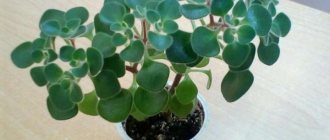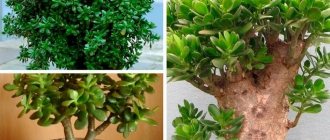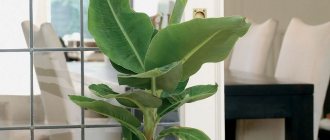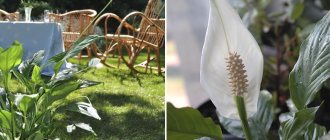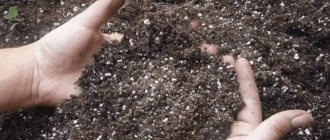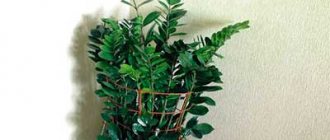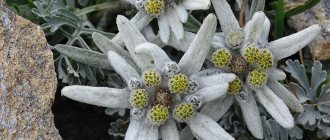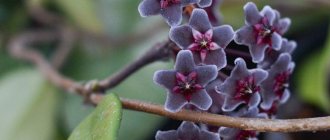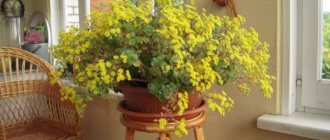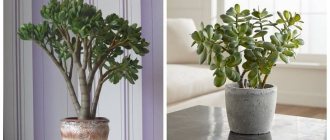Synadenium from the Euphorbiaceae family belongs to succulent plants. An exotic representative of the flora came to the windowsills of apartments and houses from the tropical and subtropical zones of arid Africa.
In literature and in everyday life, you can often find another name for the flower - the tree of love (why the plant is called this still remains unknown).
Description and popular types
Synadenium in the wild is represented by succulent trees and shrubs with thick, erect stems and dense oval-shaped leaf plates, which are attached with short petioles. The arrangement of glossy, leathery leaves is opposite or alternate. In the wild, the genus has about 20 varieties, of which only two are common in indoor floriculture:
- Synadenium Grantii is a branching shrub with numerous shoots. Thanks to pinching, you can achieve the formation of a standard tree. The color is rich green. However, variegated varieties are sometimes found.
- Synadenium Rubra - a distinctive characteristic of the species are large leathery leaf plates, painted with burgundy patterns of various shapes.
Indoor flower synadenium under the gun of botanists
The plant belongs to the Euphorbiaceae family and is a succulent. Typically grows in tropical and subtropical areas of arid Africa. Thanks to the unique structure of tissues, it is able to store and retain a sufficient amount of liquid. Reaches 3-4 m in height. As they grow, the succulent shoots become covered with pale gray bark. There are up to 20 species in the exotic genus.
However, only two are grown at home:
- Synadenium Granta. It is a shrub with rich green or variegated foliage. It is distinguished by its numerous branching shoots, which are formed into a standard tree by pinching.
- Synadenium Rubra. A characteristic feature of the variety is its unusual color. The leathery leaves are covered with intricate patterns or spots of burgundy-purple. Young specimens have a beautiful pink tone.
In nature (in winter), spurge produces thyroid inflorescences. The peduncles are located in the upper part; the red shoots are presented in the form of inverted bells. At home, exotic blooms very rarely.
It is the leaves that create a unique decorative effect for a tropical plant. They are arranged alternately on short petioles. They reach a length of 25 cm and a width of 12 cm. The oval-shaped plates are light green in color. Dark veins give the indoor synadenium flower a certain mystery. The surface of the leaves is glossy and leathery, hard to the touch. The roots are of particular value to the succulent. Due to their good branching and fleshiness, they accumulate a lot of moisture. Then, during drought, the root system rationally uses up liquid reserves, so the flower survives even in harsh conditions.
Blooming synadenium
The tree of love or Euphorbia palmum in its natural habitat blooms in the winter season, when flower stalks of varying lengths develop from the upper axils of the leaves, depending on the species.
The arrows are crowned with umbrella inflorescences, consisting of small red flowers, which are shaped like bells. Over time, in place of the flowers, seed pods are formed, divided into 3 segments.
At home, witnessing the flowering of synadenium is very rare.
Synadenium in the house: benefits and harm
The milky sap contained in the plant is very poisonous. If it comes into contact with the skin, it causes irritation or an allergic reaction, and if it gets inside the body, it causes poisoning. Therefore, you should not place synadenium in places accessible to children.
The plant also has beneficial properties. A tincture is made from the roots of the plant, which is used for diseases of the liver, kidneys, inflammation of the bladder, and headaches. But under no circumstances should you take products containing synadenium without a doctor’s prescription.
Synadenium, despite its African origin, is successfully grown indoors. It is valued by many not only for its decorative qualities, but also for its unpretentiousness. Even novice flower growers who want to quickly and easily green up their interior can grow the crop.
From the following video you can learn more about growing Synadenium at home:
Features of growing a flower and creating optimal conditions
Despite the fact that the flower is an unpretentious indoor crop, in order to grow a healthy exotic plant in the house, you should take into account a number of its features and create growing conditions close to natural ones.
Requirements for the placement of synadenium and lighting
A native of Africa loves a large amount of bright, but soft light , which he can receive through windows of eastern or western orientation.
If you install a pot with synadenium on the windowsill of southern windows, you should organize shading during the midday hours, when active sunlight can cause burns on the beautiful leaves of the flower.
In winter, when daylight hours are reduced and the temperature remains at the same level, it is recommended to provide artificial lighting to prevent the plant's shoots from stretching.
Temperature
During the period of intense flower growth, the optimal temperature regime is 22-25°C. With the arrival of autumn cold, if it is not possible to install an additional light source, it is recommended to reduce the room temperature to 15°C.
Carefully! The critical minimum for synadenium is 10°C.
Humidity
The drought-resistant succulent adapts perfectly to dry indoor air and does not need to additionally increase the humidity level.
As a hygienic procedure, the purpose of which is to clean the shoots from dust, the leaves are wiped with a damp sponge.
Soil requirements
Synadenium is not picky about soil composition and does well in a loose substrate with a neutral reaction. You can prepare the soil mixture yourself by combining equal parts of peat, sand and leaf soil.
Succulent care
Synadenium, the care of which consists of standard measures, will delight the grower with its decorative appearance and excellent health for the care and attention provided.
Watering
Synadenium, being a succulent. It is drought-resistant and can tolerate lack of moisture for several weeks.
But for full development, it is recommended to water the flower during the period of intensive growth as the surface layer of the earthen coma dries out. The rest of the time, it is enough to moisten the substrate twice a month.
Advice! If the leaves of the synadenium droop, giving up the accumulated moisture, then resuming the irrigation regime will not correct the situation. It is recommended to cut off drooping shoots so that new ones develop faster.
Feeding
The substrate should be enriched with nutrients necessary for the full development of synadenium only during the active growing season, which occurs in spring-summer. Feeding is carried out every 2 weeks using liquid mineral fertilizers for succulents or cacti.
Transfer
Caring for synadenium at home involves transplanting, the frequency of which depends on the age of the plant. While synadenium is actively developing, the crop will need to be replanted annually.
As they grow older, the interval increases to 3-4 years, during which only the top layer of the depleted substrate is renewed.
The procedure is carried out in early March according to the following scheme:
- A larger pot is selected.
- The bottom is lined with a drainage layer of stone chips or gravel.
- The drainage is lightly sprinkled with a substrate, onto which the flower with an old earthen lump is rolled over.
- The resulting space is filled with nutritious soil mixture.
Features of seasonal care
Synadenium grows actively in the spring and summer. It requires warmth, good lighting, moderate watering and feeding. In winter, the plant enters a period of relative dormancy. It is better to spend it in a cool place. In such conditions, the amount of light is reduced and watering should become less frequent. If the succulent remains to spend the winter in a warm room, it needs to be provided with additional lighting with phytolamps. If this is not done, the branches of the plant will begin to stretch and become bare, and some of the leaves will fall off.
Formation of the crown of synadenium
Formative pruning is carried out in early spring , when the side shoots are removed and the central trunk is pinched to form a tree.
If the plant develops in the form of a bush, then pruning is still carried out, since it stimulates strong branching. Sanitary pruning, in which damaged, dried shoots are cut off, is recommended to be carried out as necessary.
Important! Synadenium juice is poisonous, so all work with the flower is carried out with gloves.
Syngonium - signs and superstitions
Like most indoor plants, syngonium has acquired a considerable number of signs and superstitions that consider the flower from both a positive and negative side.
Signs about syngonium
If indoor plants could choose their professions, then Syngonium would probably become a weather forecaster. The fact is that this green pet is able to predict the approach of rain. Before precipitation, syngonium begins to “cry”: droplets of water form on the pointed tips of its leaves.
A similar phenomenon, characteristic of this vine, can be quite logically explained from the point of view of science. Coming from tropical forests, syngonium has a special love for moisture, and droplets of water on the tips of the leaves are its natural reaction to high air humidity, which often precedes rain.
Positive superstitions about syngonium
Syngonium has not been spared by popular superstitions - they are associated with the energy of this indoor plant.
Superstitions that attribute syngonium a beneficial effect on a person and the atmosphere of his home:
- Syngonium is a flower that guards family happiness.
- Just as a plant itself changes and transforms over time, it also changes the people around it:
it creates in their minds
a craving for changes in life.
For this reason, syngonium is recommended for inveterate conservatives who are suspicious of everything new and dissatisfied with the modern world. Liana will smooth out their difficult temperament, instill loyalty and tolerance. - If a person is not a conservative to the core, but dreams of saying goodbye to the past
, which pulls him back and does not allow him to breathe deeply, he is simply obliged to start a syngonium. An indoor flower will speed up this separation and make it more painless. - Syngonium is considered a symbol of positive change,
so it is believed that the vine
speeds up the patient’s recovery.
If various diseases are frequent guests in the family, be sure to allocate a place in the house for this plant. - According to another belief, syngonium has the ability to eliminate bad dreams and nightmares
. Therefore, people suffering from these nocturnal phenomena should place this green companion in their bedroom. - Another belief says that syngonium successfully fights any complexes and helps to establish contacts with others.
In this regard, it is recommended to keep the vine at home for people suffering from self-doubt and those who find it difficult to communicate with other members of society. - Syngonium will also help you quickly learn new knowledge and adapt to a new environment.
For this purpose, newly graduated students can begin to grow it, especially since caring for this indoor flower will require a minimum of effort from the owners.
Negative superstitions about syngonium
Many amateur flower growers would be happy to add syngonium to their home flower collection, but they are stopped by the negative superstitions associated with this vine. Let's look at the most common ones.
However, an analysis of various flower growing forums refutes this superstition: young ladies and ladies write that representatives of the stronger half of humanity get along well with the syngonium and are in no hurry to leave home. Therefore, we can say that this belief is not the truth at all, but an ordinary prejudice that has no basis.
According to Feng Shui, “poisonous breath”, which poisons people and negatively affects their lives, is emitted by all the sharp corners that exist in the home. Indoor plants with arrow-shaped leaves also have the same property. It is logical to assume that syngonium received the fame of “poisonous breath” precisely because of its arrow-like leaves. If this fact scares you, do not rush to get rid of the plant, but follow the advice of Feng Shui masters: place protective amulets next to the syngonium that can neutralize negative energy.
If you look at the second superstition from a scientific point of view, it can be explained by the presence of poisonous milky juice in Syngonium (a characteristic feature of all Aroids), which can cause irritation on the skin or lead to poisoning if ingested. Therefore, for safety reasons, any manipulation with this vine is best done with gloves and kept away from children and pets.
Protecting synadenium from diseases and pests
A succulent with poisonous juice cannot be called the favorite food of harmful insects.
However, sometimes a weakened plant may experience damage from scale insects, spider mites or mealybugs, which infest indoor flowers when the air is very dry.
As a protective measure, synadenium shoots are sprayed with an insecticide.
With systematic overwatering and low temperatures, the development of gray rot can be observed, which can be cured in the early stages by transplanting synadenium into a fresh substrate and subsequent treatment with a fungicide according to the manufacturer’s instructions indicated on the package.
Attention! Spraying with pesticides should be carried out in the fresh air with a clod of earth previously protected from the possibility of ingress of drugs.
Problems during cultivation
This flower does not cause much trouble. The plant is persistent; the main thing is to choose a place for it and water it correctly.
Sometimes the following problems occur:
1. Leaves are falling. This usually happens when the maintenance conditions change sharply: the temperature drops, cold water is used for irrigation, overflow or transplantation takes place. In this case, the flower itself quickly recovers. But if the leaves continue to fall, you need to inspect the roots - they may rot from cold or waterlogging. The flower is rehabilitated as follows: the bad roots need to be cut off and the flower replanted in new soil.
2. The leaves are falling. The flower requires watering. After watering, the plant quickly recovers.
3. Branches are strongly stretched. This happens due to a lack of light. Pruning and constant diffused sunlight will help restore the shape.
This unpretentious flower, having appeared in your home, will quickly become familiar. Its requirements are minor, and the brightness of its foliage makes it one of the most decorative indoor plants. Synadenium Granta is not as popular as other succulents, but it is very unpretentious and comes in many varieties! Synadenium Granta care and types in this article.
Family: Euphorbiaceae. Flowering: no. Growing: simple.
Propagation of synadenium
Euphorbia synadenium propagates by seeds and vegetatively - by cuttings.
By cuttings
During the procedure:
- Cuttings 10-15 cm long are cut from the apical shoots.
- The cut areas are sprinkled with crushed charcoal, after which the cuttings are dried in air.
- After the formation of a film on the cuts, the planting material is buried in a pre-calcined soil mixture of peat and sand by 2-3 cm.
- The container with the plantings is transferred to a bright room with a temperature of 20°C.
- When shoots begin to appear on the cuttings, indicating rooting, new specimens of synadenium are planted in permanent pots with substrate for adult plants.
Seed method
A more labor-intensive technique, which is carried out by experienced and dedicated flower growers. In the spring, a container for seedlings is prepared, which is filled with sand and peat substrate.
Synadenium seeds are distributed over the surface of the soil mixture, after which they are sprinkled with a 1 cm layer of sand. The crops are moistened and covered with glass. After 10-14 days of being in a bright and warm room, the first shoots appear and the glass is removed.
When the seedlings reach a height of 10 mm, the first dive is carried out. For subsequent procedures in permanent pots, a height of 30 mm is required.
In this video, once again, briefly about caring for synadenium:
Recommendations for cultivation
It doesn’t matter which variety you choose for your home, Rubra or Granta, home care is no different and comes down to following the simplest measures:
- There must be enough light and warmth. Optimal temperature parameters: in the spring-summer period 25-27 ° C, in winter not lower than +12-15 degrees. It is better to grow a flower on a windowsill on the south side, while shading the plant is necessary to prevent sunburn. On cloudy days, it is necessary to illuminate the plant with special ultraviolet lamps. Insufficient lighting leads to excessive elongation and further bending of the stem, paleness and falling of the foliage. In the hot season, you can take the pot with milkweed to the balcony or loggia, provided that there are no open drafts. During the cold period, you need to provide the synadenium with a cooler room for winter sleep.
- Watering is moderate and infrequent. It is necessary to carefully monitor the milkweed and not allow the substrate in the pot to become waterlogged. Drought is quite a common phenomenon for succulents, but the abundance of moisture encourages the development of pathogenic microflora and putrefactive processes on the roots. Usually they water only after the soil has completely dried 2-3 cm deep, and leaf spraying, traditional for many other indoor plants, is completely contraindicated for synadenium.
- Formative pruning is required. The active growth of the flower should be controlled: promptly pinch the tops of young shoots and remove defective side branches, then it will be possible to form a small spreading shrub with a powerful, spreading crown. And, conversely, shorten the side shoots without touching the central one in order to grow a slender tree. It is best to prune in the spring, immediately before replanting, during the period of active growth of green mass. Use a sharp knife or pruning shears to carefully cut off unnecessary stems, and treat the wound sites with charcoal (charcoal or activated).
- Fertilization and frequent replanting are encouraged. The spreading root system of the plant requires a spacious flowerpot and an abundance of nutritious soil. Spring transplants will be required every year or two with the choice of a larger pot. A good substrate for synadenium will be a mixture of garden soil, peat and sand, with the addition of useful components (humus and wood ash); you will also need good drainage. To increase looseness, you can even add a small portion of brick chips directly into the soil to improve the soil's throughput and prevent water stagnation. Periodically you will need to apply fertilizer complexes, alternating mineral and organic fertilizers. You can purchase a ready-made complex “For cacti” or use the popular “Ammophos”, ammonium sulfate and apply in doses every two weeks.
Signs associated with synadenium
There are no known superstitions and signs associated with the negative impact of synadenium on the inhabitants of the house where it is kept. But there is an opinion among people that you should not keep the flower in the bedroom, which is explained by its poisonous juice.
Thus, a representative of the tropical flora, synadenium is a spectacular plant that can decorate the home of even inexperienced gardeners who want to landscape the premises.
Care errors and their elimination
The table contains useful information for gardeners about frequently encountered problems when growing Synadenium and methods for eliminating them:
| Problem | Causes | Solution |
| Dropping leaves | A sharp drop in temperature, watering with cold water, waterlogging | Do not overcool synadenium, water only with warm, settled water |
| Drooping and wrinkling of leaves | Moisture deficiency | Water the plant |
| Pulling out the stems | Lack of lighting | Provide constant allowance for diffuse lighting |
Description of the flower
Ficus Synadenium Granta is considered very tall. In the wild it can grow more than those and a half meters. Southern Africa is considered the birthplace of this plant.
Young shoots are bright, juicy green, and with age they are covered with light gray bark. The leaves are short-petiolate, obovate, smooth-rimmed, and arranged alternately on the shoot. They are light green in color with bright veins reminiscent of wood. Length-15 centimeters, width-6.
During flowering, the upper leaf axils form a small, few-flowered peduncle, red, umbrella-shaped. As soon as the plant fades, small fruits appear on its branches.
Home care for Synadenium
Let's consider caring for Synadenium Granta at home. It is unpretentious to grow at home, but does not please the owner with flowering.
Lighting requirements
Prefers good, certainly diffused, lighting. It is better to give preference to windows located on the western or eastern side.
With a lack of light rays, the stems become weak, stretch out, and the plant takes on an unhealthy appearance. With excessive lighting and direct sunlight, the flower receives numerous burns and the leaf becomes covered with brown spots.
Temperature requirements
The Synadenium Granta tree is a heat-loving tree; from spring to late summer, the room temperature must be kept at 23-26 degrees. In winter, the temperature should be kept cooler, but not fall below 10 degrees, otherwise the leaf cover will fall off.
The amount of heat in the room is directly proportional to the required light. If necessary, additional artificial lighting is created. If ignored, the internodes lose their elasticity and the foliage falls off.
Soil moisture requirements
In the wild, it prefers semi-arid areas, so watering at home must be approached responsibly. As soon as the upper part of the soil (1-2cm) dries out, it is time to moisten the soil.
After the procedure, excess liquid must be drained from the pan. Prolonged waterlogging promotes the spread of rot.
Overdrying also has a negative impact on life activity, and leaf cover may decrease.
If the winter is cold, watering should be kept to a minimum, but do not forget to monitor the rate at which the soil dries out.
For irrigation, it is recommended to use soft, settled water.
Humidity Requirements
It does not require additional humidification, since it is accustomed to dry air; for hygiene purposes, it is possible to use a warm shower.
How to prune Synadenium Granta
High growth rates contribute to a rapid increase in plant volume. Within one year, the flower can grow 25 centimeters.
Regular pruning is necessary to control growth. Thanks to this procedure, the plant can be shaped.
Soil requirements
The soil must be light, enriched with nutrients, and with an average acidity level.
As an earth mixture, you can use a substrate of peat, humus, turf soil, coarse sand and brick chips, taken in equal proportions. To prevent the formation of rot, it is recommended to add a little charcoal to the soil and prepare clay drainage or expanded clay.
It is allowed to use finished products, but adding a certain amount of coarse sand and brick chips, as experienced gardeners advise.
Requirements for transplantation
While the plant is young, it requires annual replanting; with age, the amount should be reduced to once every three years. Each subsequent dish should be slightly larger than the previous one.
Planting and transplanting
To avoid stagnation of water, it needs good drainage, which is organized from expanded clay mixture and broken bricks.
A suitable potting container is deep and stable, made of clay or expanded clay, the porous walls of which are capable of allowing air and moisture to pass through.
Planting technology:
- the bottom is laid out with drainage;
- the pot is filled ½ full with substrate;
- The flower is placed in the central part, the roots are straightened and sprinkled with earth mixture.
It is possible to make a soil mixture yourself by combining peat, leaf soil and coarse river sand.
It is better to replant in the spring.
The regularity of transplantation depends on the age of the flower crop:
- the young plant is replanted almost every year;
- from 4-5 years old, replace the potty every three years;
- For old succulents, they try not to change the growth conditions; they make do with replacing the surface layer of the substrate by 4-5 cm.
The best time for replanting is early spring, most often March. The preferred method is transshipment while preserving the earthen clod.
Temperature and lighting when caring for a flower
Caring for Synadenium Granta is almost the same as caring for other succulents of the Euphorbiaceae family.
The plant feels good in diffused light both in winter and summer. When there is insufficient lighting, the flower begins to stretch and loses its appearance. Therefore, in winter it is necessary to provide it with additional lighting. If this is impossible to do for some reason, then it is advisable to reduce the temperature in order to temporarily stop the growth of the plant.
In the summer, a glazed, ventilated balcony is suitable for the flower - it will be as comfortable as possible there. The optimal temperature for Grant's synadenium is considered to be 23-26 degrees. The plant tolerates hot summer weather well and adapts to cool weather (up to +10 degrees). The temperature should not drop below, as this may affect the plant (high risk of root death).
Purchase rules and adaptation period
The best time to buy is spring. During the spring-summer period, the indoor plant will have time to adapt to new growing conditions, strengthen itself and increase its vegetative mass before the dormant phase.
The average price is 500 rubles.
When purchasing synadenium, you should pay attention to its appearance. In a healthy flower crop:
- bright, rich leaf color without spotting or signs of pests;
- intact root system.
The first 2 weeks give the newly purchased plant time to adapt; it is not replanted or fed. Subsequently, care is provided in accordance with the basic rules.
The necessary conditions
Suitable location and soil requirements
Requires a large amount of light (diffused).
Synadenium can grow in any direction, but east and west are best suited.
When placed in the south, it needs shading to avoid foliage burns; in the north, it needs additional lighting.
For planting a house plant, a soil mixture designed for growing succulents is suitable.
Add charcoal and brick or expanded clay chips to the soil for indoor plants. The first component serves as an antibacterial agent for the prevention of root rot, the second acts as a leavening agent and improves the drainage properties and aeration of the substrate.
Temperature
Needs to maintain a constant temperature within 20-26°C, because... its resting phase is practically absent or weakly expressed.
The maximum temperature is 30°C, the minimum is 10°C.
- Sudden changes combined with drafts cause the leaf mass to fall off.
Humidity
The succulent can easily tolerate dry air, incl. when using heating appliances in winter. Optimal indicators are 50%.
In summer, additional shower procedures are carried out.
Spraying is not recommended. They are replaced by wiping the leaves with a damp cloth in order to remove accumulated dust and improve the process of photosynthesis.
Lighting
In low light conditions, it is necessary to use artificial additional lighting to prevent stretching of internodes and loss of decorativeness of leaves, especially in winter.
The optimal length of daylight is 8 hours or more.
